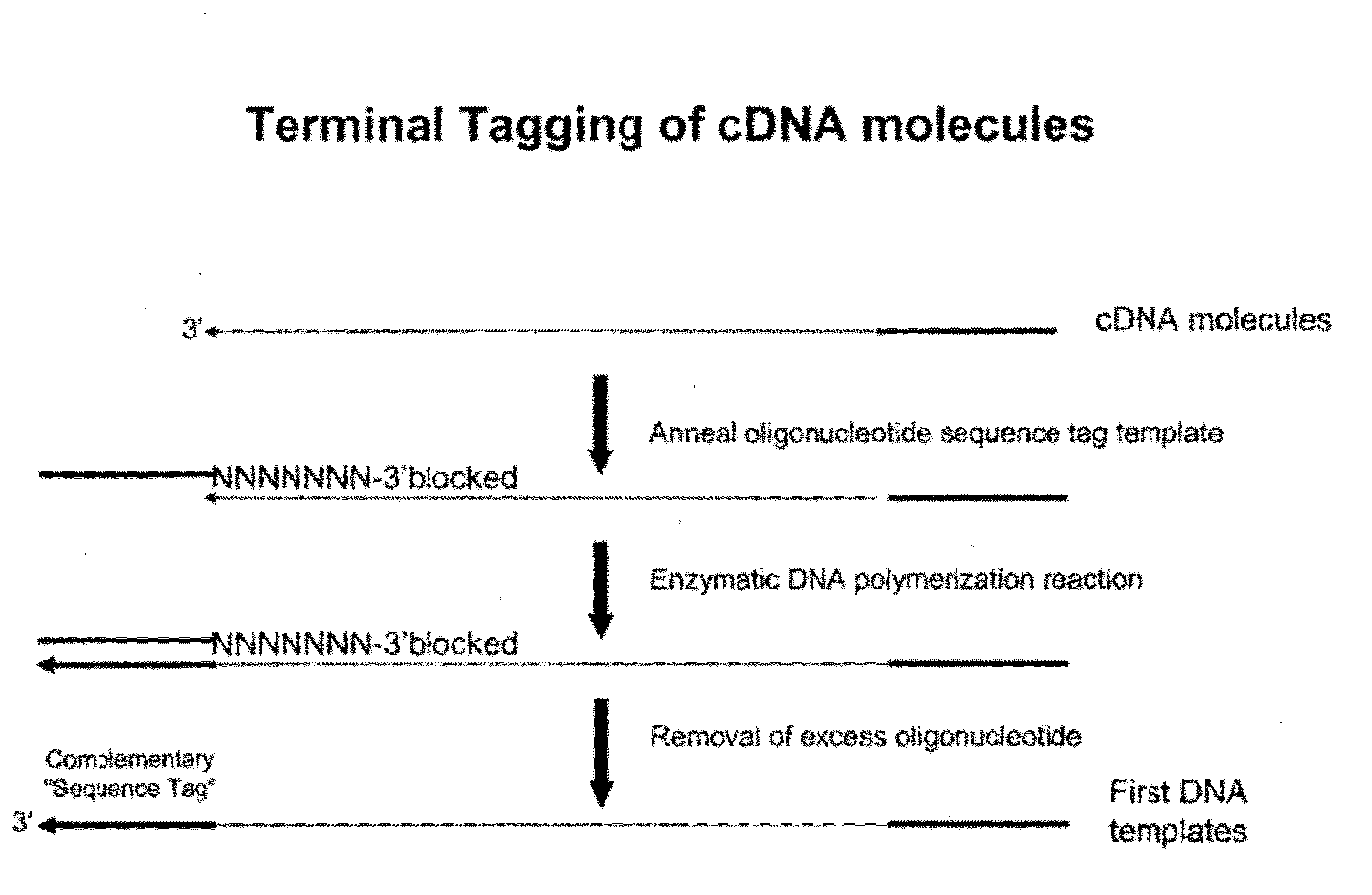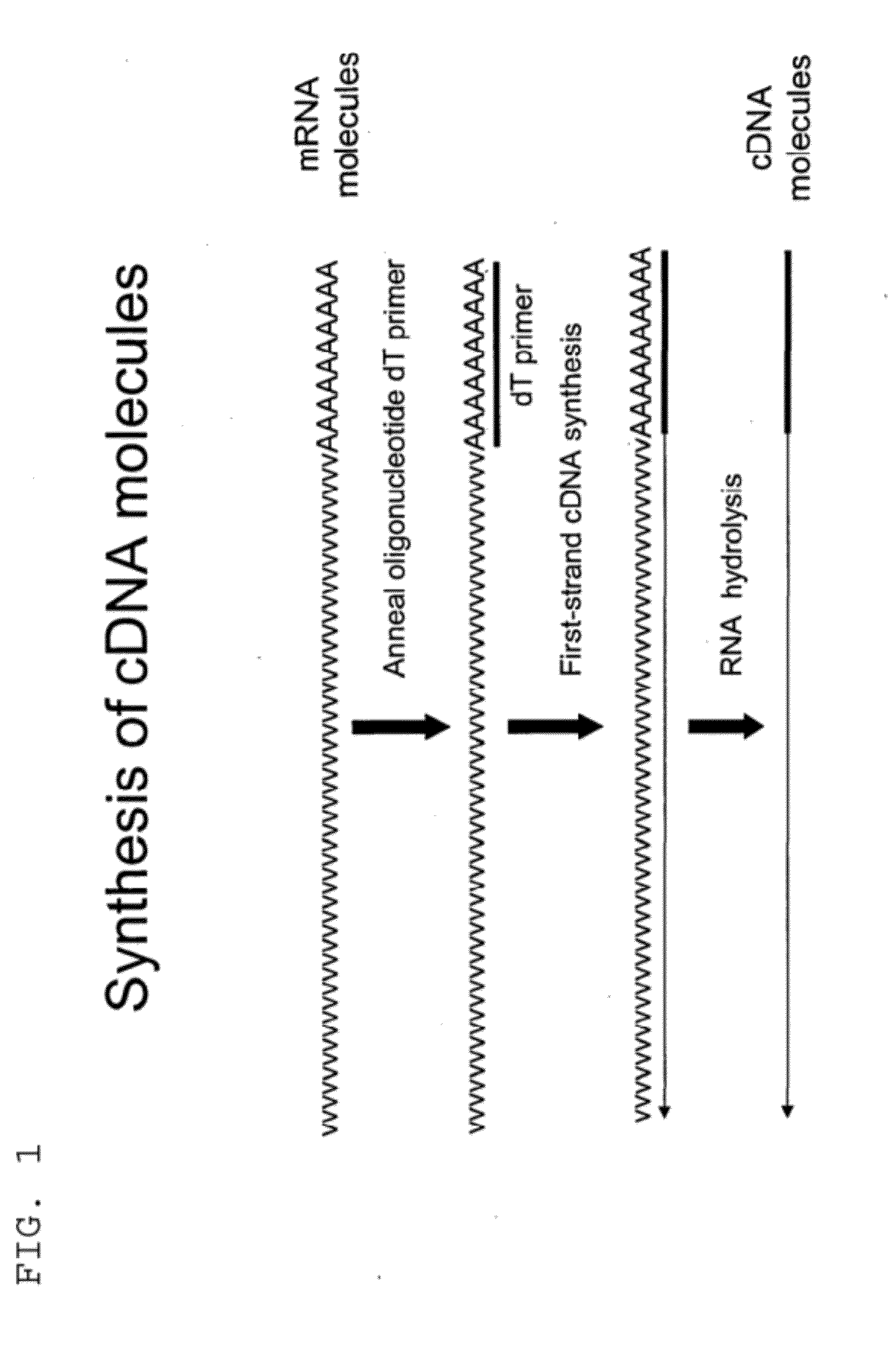Selective terminal tagging of nucleic acids
a terminal tagging and nucleic acid technology, applied in the field of selective terminal tagging of nucleic acids, can solve the problems of loss of intact mrna, loss of 5′ ends of mrna, and inability to amplify and therefore cannot be identified
- Summary
- Abstract
- Description
- Claims
- Application Information
AI Technical Summary
Benefits of technology
Problems solved by technology
Method used
Image
Examples
example 1
Attachment of an Oligonucleotide Sequence Tag to the Terminal 3′ Ends of cDNA Molecules
[0323]Total RNA from mouse brain (Ambion) was repurified using the RNeasy procedure (Qiagen). The mRNA population contained in 4 μg of total RNA was used for making first-strand cDNA in a standard cDNA synthesis reaction containing 7.5 μM oligo dT primer (Seq. ID. No. 1; (dT)20V (V=A, C or G) containing a 5′-Not I restriction endonuclease sequence in order to facilitate cloning), 10 mM Tris-HCl (pH 8.3), 50 mM KCl, 6 mM MgCl2, 5 mM DTT, 1 mM dATP, 1 mM dGTP, 1 mM dCTP, 1 mM TTP and a reverse transcriptase in a final volume of 20 μL. The reaction was allowed to proceed for 60 minutes at the recommended incubation temperatures. The RNA templates were then removed by enzymatic digestion with RNase A and H simultaneously, and the cDNA purified and recovered in 50 μL EB buffer (Qiagen) (see schematic of FIG. 1 for illustration).
[0324]The purified first-strand cDNA molecules were then divided into 2 equ...
example 2
Transcription of the First DNA Templates
[0326]The DNA templates from each of the 2 reactions in Example 1 were used for priming DNA synthesis using a second oligonucleotide template containing a 5′ T7 promoter sequence (italicized) and a 3′ sequence tag (Seq. ID. No. 3; AATTCTAATACGACTCACTATAGGGAGACGAAGACAGTAGACA) similar to the sequence tag contained in the first oligonucleotide to form second DNA templates containing a T7 promoter sequence. The DNA synthesis reactions (50 uL) contained the respective DNA templates, 5 pmoles second oligonucleotide template (Seq. ID. No. 3), 40 mM Tricine-KOH (pH 8.7), 15 mM KOAc, 3.5 mM Mg(OAc)2, 3.75 μg / mL BSA, 0.005% Tween-20, 0.005% Nonidet-P40, 200 μM dATP, 200 μM dGTP, 200 μM dCTP, 200 μM TTP and 2 μL Advantage 2 Polymerase mix (BD Biosciences). The reactions were heated at 95° C. for 1 minute 30 seconds, 50° C. for 1 minute, 55° C. for 1 minute and finally, 68° C. for 30 minutes before phenol was added to terminate the reaction. In addition t...
example 3
Amplification in PCR of Specific DNA Sequences Contained in a Library of First DNA Templates Using a First Primer Corresponding to the Oligonucleotide Sequence Tag and Gene Specific Second Primers
[0333]In vitro transcribed RNA (5 μg) generated in Example 2 containing the oligonucleotide sequence tag at its 5′ proximal end was reverse transcribed in a standard cDNA synthesis reaction (In Vitrogen) and the resulting first-strand cDNA was purified and reconstituted in 20 μL H2O. Four PCR amplification reactions were assembled, each containing 40 mM Tricine-KOH (pH 8.7), 15 mM KOAc, 3.5 mM Mg(OAc)2, 3.75 μg / mL BSA, 0.005% Tween-20, 0.005% Nonidet-P40, 200 μM dATP, 200 μM dGTP, 200 μM dCTP, 200 μM TTP and 2 μL Advantage 2 Polymerase mix in a final volume of 50 μL. To reactions 1 and 2, 20 picomoles of each of a forward primer (first primer) (Seq. ID. No. 4; TTGGCGCGCCTTGGGAGACGAAGACAGTAGA), which is complementary to the sequence tag on the 3′ proximal end of the synthesized cDNA and a ge...
PUM
| Property | Measurement | Unit |
|---|---|---|
| Mass | aaaaa | aaaaa |
| Mass | aaaaa | aaaaa |
| Mass | aaaaa | aaaaa |
Abstract
Description
Claims
Application Information
 Login to View More
Login to View More - R&D
- Intellectual Property
- Life Sciences
- Materials
- Tech Scout
- Unparalleled Data Quality
- Higher Quality Content
- 60% Fewer Hallucinations
Browse by: Latest US Patents, China's latest patents, Technical Efficacy Thesaurus, Application Domain, Technology Topic, Popular Technical Reports.
© 2025 PatSnap. All rights reserved.Legal|Privacy policy|Modern Slavery Act Transparency Statement|Sitemap|About US| Contact US: help@patsnap.com



